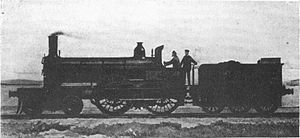Our website is made possible by displaying online advertisements to our visitors.
Please consider supporting us by disabling your ad blocker.
NBR 224 and 420 Classes
| NBR 224 and 420 Classes | |||||||||||||||||||||||||||||||||||||||
|---|---|---|---|---|---|---|---|---|---|---|---|---|---|---|---|---|---|---|---|---|---|---|---|---|---|---|---|---|---|---|---|---|---|---|---|---|---|---|---|
 224 Class, as built | |||||||||||||||||||||||||||||||||||||||
| |||||||||||||||||||||||||||||||||||||||
| |||||||||||||||||||||||||||||||||||||||
| |||||||||||||||||||||||||||||||||||||||
| [1][2][3] | |||||||||||||||||||||||||||||||||||||||
The NBR 224 and 420 Classes consisted of six steam locomotives of the 4-4-0 wheel arrangement built by the North British Railway (NBR) in 1871 and 1873. No. 224 had three claims to fame: it was the first inside-cylinder 4-4-0 engine to run in Great Britain;[4] it was the locomotive involved in the Tay Bridge disaster;[5] and after rebuilding in 1885, it was the only compound-expansion locomotive on the NBR, and one of just three tandem compounds in Britain.[6]
Intended for express passenger trains on the Edinburgh–Glasgow, Edinburgh–Carlisle, and Burntisland–Dundee routes, they handled these well. When trains from London to Edinburgh began to be forwarded via Carlisle over the NBR in mid-1876, these heavier trains were beyond the locomotives' capabilities, and they had to be removed from front-line service on the Carlisle line. Rebuilt between 1885 and 1897, they remained in service until 1914–19.
- ^ Ahrons 1987, p. 195.
- ^ Highet 1970, pp. 88–90.
- ^ SLS 1970, pp. 66–68.
- ^ Boddy et al. 1968, p. 5.
- ^ Rolt & Kichenside 1982, p. 98.
- ^ Ahrons 1987, pp. 260, 262.
Previous Page Next Page


